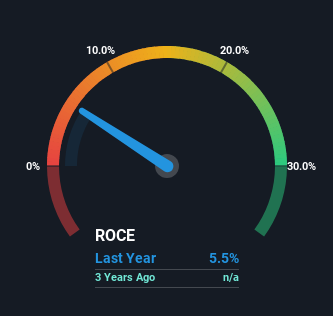Enhabit (NYSE:EHAB) Will Be Looking To Turn Around Its Returns
To avoid investing in a business that's in decline, there's a few financial metrics that can provide early indications of aging. Businesses in decline often have two underlying trends, firstly, a declining return on capital employed (ROCE) and a declining base of capital employed. Trends like this ultimately mean the business is reducing its investments and also earning less on what it has invested. So after glancing at the trends within Enhabit (NYSE:EHAB), we weren't too hopeful.
Return On Capital Employed (ROCE): What Is It?
If you haven't worked with ROCE before, it measures the 'return' (pre-tax profit) a company generates from capital employed in its business. To calculate this metric for Enhabit, this is the formula:
Return on Capital Employed = Earnings Before Interest and Tax (EBIT) ÷ (Total Assets - Current Liabilities)
0.055 = US$76m ÷ (US$1.5b - US$136m) (Based on the trailing twelve months to March 2023).
Therefore, Enhabit has an ROCE of 5.5%. In absolute terms, that's a low return and it also under-performs the Healthcare industry average of 9.5%.
Check out our latest analysis for Enhabit
In the above chart we have measured Enhabit's prior ROCE against its prior performance, but the future is arguably more important. If you'd like, you can check out the forecasts from the analysts covering Enhabit here for free.
What The Trend Of ROCE Can Tell Us
In terms of Enhabit's historical ROCE movements, the trend doesn't inspire confidence. About two years ago, returns on capital were 7.4%, however they're now substantially lower than that as we saw above. On top of that, it's worth noting that the amount of capital employed within the business has remained relatively steady. Companies that exhibit these attributes tend to not be shrinking, but they can be mature and facing pressure on their margins from competition. So because these trends aren't typically conducive to creating a multi-bagger, we wouldn't hold our breath on Enhabit becoming one if things continue as they have.
In Conclusion...
In summary, it's unfortunate that Enhabit is generating lower returns from the same amount of capital. Long term shareholders who've owned the stock over the last year have experienced a 27% depreciation in their investment, so it appears the market might not like these trends either. That being the case, unless the underlying trends revert to a more positive trajectory, we'd consider looking elsewhere.
Enhabit does have some risks though, and we've spotted 1 warning sign for Enhabit that you might be interested in.
While Enhabit may not currently earn the highest returns, we've compiled a list of companies that currently earn more than 25% return on equity. Check out this free list here.
Have feedback on this article? Concerned about the content? Get in touch with us directly. Alternatively, email editorial-team (at) simplywallst.com.
This article by Simply Wall St is general in nature. We provide commentary based on historical data and analyst forecasts only using an unbiased methodology and our articles are not intended to be financial advice. It does not constitute a recommendation to buy or sell any stock, and does not take account of your objectives, or your financial situation. We aim to bring you long-term focused analysis driven by fundamental data. Note that our analysis may not factor in the latest price-sensitive company announcements or qualitative material. Simply Wall St has no position in any stocks mentioned.
Join A Paid User Research Session
You’ll receive a US$30 Amazon Gift card for 1 hour of your time while helping us build better investing tools for the individual investors like yourself. Sign up here

 Yahoo Movies
Yahoo Movies 
